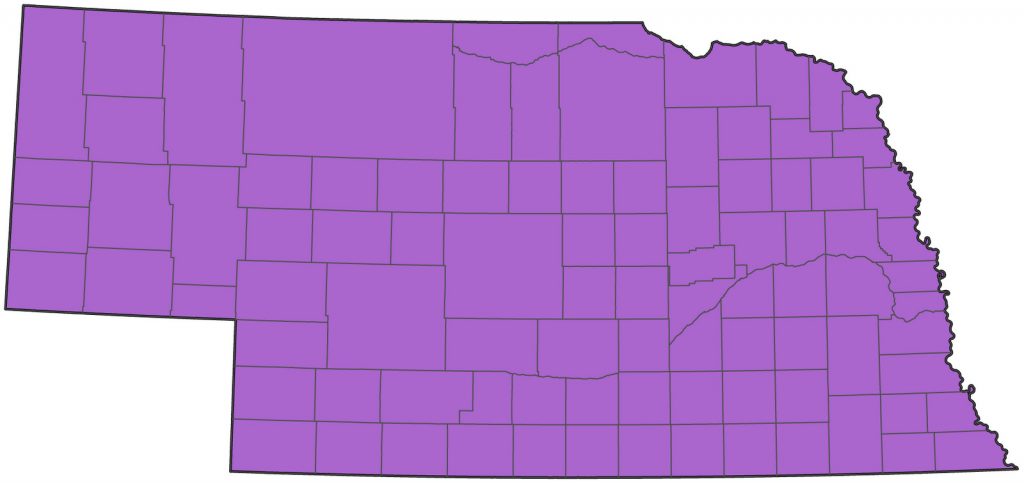Columba livia
Status: Common regular resident statewide.

Documentation: Specimen: UNSM 13458, 26 May 1977 Lincoln, Lancaster Co.
Taxonomy: In the strict sense, Columba livia refers to the Rock Dove of Eurasia east to central Asia and Africa; North American Rock Pigeons are an amalgamation of several wild subspecies from the native range in central Asia (AOU 1957) as well as released or escaped domestic birds.
According to Clements et al (2016), “Rock Pigeon” conflicts with established names in Australia for species of Petrophassa, but “Feral Pigeon” is available for worldwide introduced populations. Here, we retain “Rock Pigeon” due to its general use in North America (AOS 2017).
A flock of all-white Rock Pigeons, best count seven, was at Marsh Wren Community Wetlands, Lancaster Co at least 23 Aug-16 Sep 2020.
Resident:
BBS data indicate that in summer numbers are greatest in the east, declining towards the north and west; this is probably a reflection of human population distribution.
- Breeding Phenology:
- Copulation: 21 Apr
Nestbuilding: 29 Mar- 13 Jul - Eggs: 27 Jan- 21 Nov (Mollhoff 2022)
Nestlings: 9 Apr- 26 Jul
Breeding may occur in almost any month; Kansas data indicate breeding Feb-Sep (see Lowther and Johnston 2014).
- High (non-CBC) counts: 1300 along Front Road, North Platte. Lincoln Co 16 Dec 2023, 770 on grain pile Gering WTP, Scotts Bluff Co 30 Oct 2024, 660 in Salt Creek area, Lincoln, Lancaster Co 15 Feb 2016, and 650 in Lincoln, Lancaster Co 27 Jan 2023.
In winter, CBC data show the same distribution as BBS data, although CBC numbers recorded in the west, notably at Scottsbluff, are proportionately higher than that shown by the BBS data. It is possible that the large number of Rock Pigeons that nest in cliffs and escarpments in the Scottsbluff area winter in Scottsbluff. Highest CBC counts are from Lincoln, 2693 in 2014 and 1701 in 2015, Norfolk, 1208 in 2007, and Ames, 842 on 3 Jan 2007; Scottsbluff had a count high of 1046 on 19 Dec 2009.
Comments: Domesticated centuries ago in Europe, European immigrants brought this species with them to the New World (Long 1981). Those settling Nebraska apparently brought this species with them and many have become feral. Today it occurs statewide, essentially around human habitation where nesting sites and food are available. It is most common in larger towns and cities in the east where many ledge-like sites are available on the many multi-story buildings and beneath bridges. In the west, feral nesting on cliffs and in canyons is rare, but does occur on certain buttes in the northwest (Rosche 1982) and possibly the Wildcat Hills in Scotts Bluff Co (Rapp et al 1958).
Images
Abbreviations:
BBS: Breeding Bird Survey
CBC: Christmas Bird Count
UNSM: University of Nebraska State Museum
Literature Cited:
[AOS] American Ornithological Society. 2017. Checklist of North and Middle American Birds. http://checklist.aou.org/taxa/
[AOU] American Ornithologists’ Union. 1957. The AOU Check-list of North American birds, 5th ed. Baltimore, MD: Port City Press.
Clements, J. F., T. S. Schulenberg, M. J. Iliff, D. Roberson, T. A. Fredericks, B. L. Sullivan, and C. L. Wood. 2016. The eBird/Clements checklist of birds of the world: v2016. http://www.birds.cornell.edu/clementschecklist/download/
Long, J.L. 1981. Introduced birds of the world. New York: Universe Books.
Lowther, P.E., and R.F. Johnston. 2014. Rock Pigeon (Columba livia). The Birds of North America, Number 13.
Mollhoff, W.J. 2022. Nest records of Nebraska birds. Nebraska Ornithologists’ Union Occasional Paper Number 9.
Rapp, W.F. Jr., J.L.C. Rapp, H.E. Baumgarten, and R.A. Moser. 1958. Revised checklist of Nebraska birds. Occasional Papers 5, Nebraska Ornithologists’ Union. Crete, NE.
Rosche, R.C. 1982. Birds of northwestern Nebraska and southwestern South Dakota, an annotated checklist. Crawford, NE: Cottonwood Press.
Recommended Citation:
Silcock, W.R., and J.G. Jorgensen. 2025. Rock Pigeon (Columba livia) Version. In Birds of Nebraska — Online. www.BirdsofNebraska.org
Birds of Nebraska – Online
Updated 17 Jul 2025

